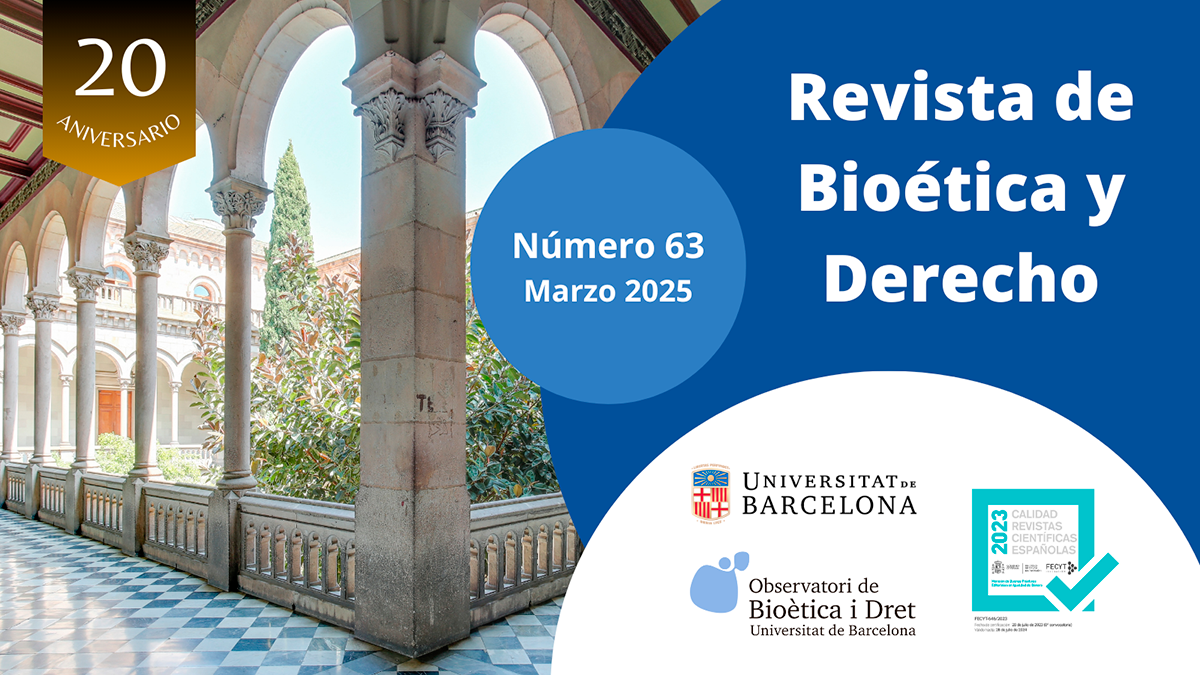DIFFICULTY IN IMPLEMENTING PALLIATIVE CARE IN AN INTERNAL MEDICINE DEPARTMENT
DOI:
https://doi.org/10.1344/rbd2025.63.47021Keywords:
end of life, nursing cares, nursing attention, death , dignityAbstract
The aging of the population, with dependency and comorbidities, has meant that care in the advanced phase of the disease has taken on special relevance. In many cases, healthcare professionals do not feel sufficiently trained to be able to provide quality palliative care, offering active and comprehensive care, so that, the aims of this study were: a) to determine whether healthcare professionals have specific knowledge of palliative care; b) to analyse whether the healthcare team is aware of the action plan to be carried out with a patient in the end-of-life care; c) to identify whether the healthcare professionals have tools for end-of-life care. Fifty-eight healthcare professionals from the Hospital Los Arcos del Mar Menor participated. The opinion on palliative care in patients at the end of life was assessed. The validated questionnaire "Palliative Care Difficulties Scale (PCDS)" was used. Significant differences (p<0.05) were found in the following variables: a) It is difficult to communicate about alleviating symptoms in multiprofessional teams; b) When a patient expresses anxiety, it is difficult to respond; c) There are no facilities that can be consulted for alleviating the symptoms of home care patients. It was concluded that there is a lack of palliative care protocols, which is why it is considered necessary for health care administrations to implement continuous training programs for health care profession.
References
Campello Vicente, C. & Chocarro González, L. (2018). Necesidades de cuidados paliativos en enfermos no oncológicos con enfermedad crónica avanzada: una revisión sistemática. Palliat Med, 25(2), 66-82. https://www.elsevier.es/es-revista-medicina-paliativa-337-articulo-necesidades-cuidados-paliativos-enfermos-no-S1134248X17300538.
Calvo Rodríguez, B. & Berdial Cabal, I. (2015). Ethical conflicts at the end of life from nurse perception. Rev Enferm. 38(10), 52-56. https://pubmed.ncbi.nlm.nih.gov/26685567/.
Chover Sierra, E. (2019) Adaptación y validación de la versión en español del Palliative Care Quiz for Nurses (PCQN). Un análisis del nivel de conocimientos en cuidados paliativos de profesionales y estudiantes de enfermería españoles. Tesis Doctoral. https://rodrigo.uv.es/handle/10550/70152.
Doblado, R.; Herrera, E.; Librada, S.; Lucas, M.; Muñoz, I. & Rodríguez, Z. (2016) Análisis y evaluación de los recursos de cuidados paliativos de España. Sociedad Española de Cuidados Paliativos; 2016.
Fernández del Riesgo (2003). La muerte hospitalaria. La muerte expropiada. Una reflexión moral. Contrastes. Revista internacional de filosofía, 3, 59-76 Málaga. https://dialnet.unirioja.es/servlet/articulo?codigo=792792.
Hernández, M.I. & Aguilar, C.R. (2016). Conocimientos del personal de enfermería sobre Cuidados Paliativos en pacientes hospitalizados de Medicina Interna. Rev Enferm, 24, 87-90. https://www.medigraphic.com/cgi-bin/new/resumen.cgi?IDARTICULO=65604.
Hiciano Guillermo, AI.; Jover Aguilar, M. & Martínez-Alarcón, L. (2020). Nivel de conocimientos en cuidados paliativos de las enfermeras; un estudio descriptivo en el Área de Salud VII de la Región de Murcia. Palliat Med, 27(2), 79-87. https://www.medicinapaliativa.es/nivel-de-conocimientos-en-cuidados-paliativos-de-las-enfermeras;-un-estudio-descriptivo-en-el-area-de-salud-vii-de-la-region-de-murcia502.
Ministerio de Sanidad (2007). Clasificación de hospitales públicos españoles mediante el uso del análisis de conglomerados. Departamento de Métodos Cuantitativos en Economía y Gestión de la Universidad de Las Palmas.
https://www.sanidad.gob.es/estadEstudios/estadisticas/docs/CMBD/CLASIFICACIONHOSPITALESCLUSTER.pdf.
Nakawaza, Y.; Miyashita, M.; Mortia, T. & Umeda, M. (2010). The palliative care self-reported practices scale and the palliative care difficulties scale: reliability and validity of two scales evaluating self-reported practices and difficulties experienced in palliative care by health professionals. Journal of Palliative Medicine,13 (4). https://doi.org/10.1089/jpm.2009.0289.
OMS Organización Mundial de la Salud (2020). Cáncer. Cuidados Paliativos. Edición digital. https://www.who.int/es/news-room/fact-sheets/detail/palliative-care.
Oriol, I. (2014). Informe de la situación actual de cuidados paliativos. AECC, Área de Programas y Servicios. Área de relaciones Institucionales. Observatorio. https://observatorio.contraelcancer.es/informes/informe-de-la-situacion-actual-en-cuidados-paliativos.
Osés, M. (2016). Actualidad en la formación de cuidados paliativos en los planes de estudio de las facultades y escuelas de Enfermería de España. SEEO, 18 (3).
Osés, M. & Casas, JM. (2017). El proceso de muerte y su desarrollo conceptual en los cuidados de enfermería. Una revisión sistemática. Ética de los Cuidados. 10(19). http://www.index-f.com/eticuidado/n19/et11318r.php.
Real Decreto 546/1995, de 7 de abril, por el que se establece el título de Técnico en Cuidados Auxiliares de Enfermería y las correspondientes enseñanzas mínimas. https://www.boe.es/eli/es/rd/1995/04/07/546.
Sociedad Española de Cuidados Paliativos (SECPAL). (2000). Recomendaciones básicas sobre formación en Cuidados Paliativos. Palliat Med, 7(1), 23-25.
Ury, W.A.; Reznich, C.B. & Weber, C.M. (2000). A needs assessment for a palliative care curriculum. J Pain Symptom Manage, 20, 408-416. https://doi.org/10.1016/s0885-3924(00)00217-7.
Valles, P. & García, I. (2013). Formación básica en cuidados paliativos: estado actual en las universidades de enfermería españolas. Medicina Paliativa, 20(3), 111-114. https://doi.org/10.1016/j.medipa.2013.03.003.
Vidal, S. (2019). Validación del cuestionario “Palliative Care Difficulties Scale (PCDS)” en población española, sobre dificultades de profesionales sanitarios en cuidados paliativos. Revista Española Salud Pública, 93. https://scielo.isciii.es/scielo.php?script=sci_arttext&pid=S1135-57272019000100034.
Vidal, S.; Fernández, M.; López, S. & Lacalle, J. (2021). Dificultades y barreras encontradas por los profesionales sanitarios en la atención de pacientes paliativos en un distrito sanitario. Medicina Paliativa, 28 (1), 32-38. https://www.medicinapaliativa.es/(X(1)S(3smo1k4e0wvvwdw2umwhcwgd))/dificultades-y-barreras-encontradas-por-los-profesionales-sanitarios-en-la-atencion-de-pacientes-paliativos-en-un-distrito-sanitario594.
Downloads
Published
How to Cite
Issue
Section
License
Copyright (c) 2024 Violeta Sabater Martinez

This work is licensed under a Creative Commons Attribution-NonCommercial-NoDerivatives 4.0 International License.
 The author retains the copyright and grants Revista de Bioética y Derecho the right of first publication of the article. All articles published in Revista de Bioética y Derecho are under Creative Commons licensing Recognition – Non Commercial – NoDerivedArtwork (by-nc-nd 4.0), which allows sharing the content with third parties, provided that they acknowledge its authorship, initial publication in this journal and the terms of the license. No commercial use of the original work or generation of derivative works is permitted.
The author retains the copyright and grants Revista de Bioética y Derecho the right of first publication of the article. All articles published in Revista de Bioética y Derecho are under Creative Commons licensing Recognition – Non Commercial – NoDerivedArtwork (by-nc-nd 4.0), which allows sharing the content with third parties, provided that they acknowledge its authorship, initial publication in this journal and the terms of the license. No commercial use of the original work or generation of derivative works is permitted.







